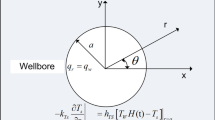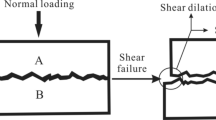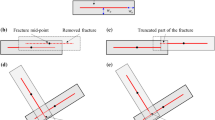Abstract
Hydraulic stimulation in enhanced geothermal systems (EGS) involves massive injection of cold fluid into target hot geothermal reservoir through a long open hole section to trigger slip on preexisting fractures and enhance permeability. Fluid injection is typically conducted at a specified rate in a step-increasing manner until the pore pressure exceeds the minimum principal stress. During each step, the injection rate is kept constant. This paper presents analytical solutions for a wellbore subjected to cooling and a constant fluid flux on borehole wall and far field in situ stress in a thermoporoelastic medium with applications to hydraulic stimulations in EGS. The temporal-spatial distribution of temperature, pore pressure and stress are obtained by means of Laplace transform and load decomposition. The results show that for granite and a typical fluid injection scenario, thermal effect is pronounced in the vicinity of the wellbore. At early time, cooling-induced pore pressure/hoop stress counteract the injection induced pore pressure/hoop stress. With increasing time, the induced pore pressure and hoop stress result predominantly from fluid injection, and cooling plays a marginal role.

















Similar content being viewed by others
Abbreviations
- α :
-
Biot coefficient
- α f :
-
volumetric thermal expansion coefficient of the pore fluid
- α s :
-
Linear thermal expansion coefficient of solid matrix
- δ ij :
-
Kronecker delta
- ε ij :
-
Strain components
- ζ :
-
Increment of fluid content
- κ :
-
Bulk thermal conductivity
- μ :
-
Coefficient of friction
- µ f :
-
Pore fluid viscosity
- ν :
-
Drained Poisson’s ratio
- ρ :
-
Mass density
- σ H :
-
Maximum horizontal principal stress
- σ ij :
-
Stress
- σ kk :
-
Bulk stress
- σ r :
-
Radial stress
- σ θ :
-
Hoop stress
- σ rθ :
-
Shear stress
- σ n :
-
Total normal stress on the preexisting fracture
- σ z :
-
Axial stress
- τ :
-
Shear stress on the preexisting fracture
- φ :
-
Porosity
- a :
-
Wellbore radius
- c :
-
Hydraulic diffusivity
- c h :
-
Bulk thermal diffusivity
- h :
-
Heat flux
- k :
-
Intrinsic permeability
- p :
-
Pore pressure
- p 0 :
-
Hydrostatic pore pressure
- p w :
-
Fluid pressure at the wellbore
- q :
-
Fluid flux
- q w :
-
Constant flux at the wellbore
- s :
-
Laplace transform variable
- B :
-
Skempton’s coefficient
- C :
-
Specific heat capacity
- CFS:
-
Coulomb failure stress
- E :
-
Young’s modulus
- G :
-
Shear modulus
- H(t):
-
Heaviside function
- K :
-
Bulk modulus of fluid-saturated rock
- K 0 :
-
Modified Bessel function of second kind of order zero
- K 1 :
-
Modified Bessel function of second kind of first order
- K 2 :
-
Modified Bessel function of the second kind of order two
- L :
-
Length of open hole section
- M :
-
Biot modulus
- N :
-
Total number of terms in the Stehfest series
- S hmin :
-
Minimum horizontal in situ stress
- S Hmax :
-
Maximum horizontal in situ stress
- S V :
-
Vertical stress
- Q :
-
Volumetric injection rate
- T :
-
Temperature change
- Ts:
-
Slip tendency
- T 0 :
-
Native fluid temperature
- T t0 :
-
Tensile strength
- T w :
-
Injected fluid temperature
References
Abousleiman Y, Chen S (2010) Poromechanics response of an inclined borehole subject to in situ stress and finite length fluid discharge. J Mech Mater Struct 5:47–66
Abousleiman Y, Cui L (1998) Poroelastic solutions in transversely isotropic media for wellbore and cylinder. Int J Solid Struct 35:4905–4929
Abousleiman Y, Ekbote S (2005) Solutions for the inclined borehole in a porothermoelastic transversely isotropic medium. J Appl Mech 72:102–114
Bai B, Li T (2009) Solutions for cylindrical cavity in saturated thermoporoelastic medium. Acta Mech Solida Sin 22:85–94
Chen SL (2019) Three-dimensional analytical poromechanical solutions for an arbitrarily inclined borehole subjected to fluid injection. Proc R Soc A Math Phy Eng Sci 475(2221):20180658
Chen S, Abousleiman Y (2016) Stress analysis of borehole subjected to fluid injection in transversely isotropic poroelastic medium. Mech Res Commun 73:63–75
Cheng AH-D (2016) Poroelasticity. Theory and applications of transport in porous media, vol 27. Springer, Berlin
Clauser C (1992) Permeability of crystalline rocks. Eos Trans Am Geophys Union 73:233–238
Detournay E, Cheng A-D (1988) Poroelastic response of a borehole in a non-hydrostatic stress field. Int J Rock Mech Min Sci Geomech Abstr 25:171–182
Evans KF, Genter A, Sausse J (2005) Permeability creation and damage due to massive fluid injections into granite at 3.5 km at Soultz: 1. Borehole observations. J Geophys Res Solid Earth 110:B04203
Fan Z, Eichhubl P, Gale JFW (2016) Geomechanical analysis of fluid injection and seismic fault slip for the Mw4.8 Timpson, Texas, earthquake sequence. J Geophys Res Solid Earth 121:2798–2812. https://doi.org/10.1002/2016JB012821
Fan Z, Parashar, R (2018) Effect of coupled porothermoelastic stress on shear stimulation of enhanced geothermal systems. In: 43rd workshop on geothermal reservoir engineering, Stanford University, Stanford, California, February 12–14 2018
Gao J, Deng J, Lan K, Song Z, Feng Y, Chang L (2017) A porothermoelastic solution for the inclined borehole in a transversely isotropic medium subjected to thermal osmosis and thermal filtration effects. Geothermics 67:114–134
Ghassemi A (2012) A review of some rock mechanics issues in geothermal reservoir development. Geotech Geol Eng 30:647–664
Kanfar MF, Chen Z, Rahman S (2016) Fully coupled 3D anisotropic conductive-convective porothermoelasticity modeling for inclined boreholes. Geothermics 61:135–148
Kurashige M (1989) A thermoelastic theory of fluid-filled porous materials. Int J Solid Struct 25:1039–1052
Li X, Cui L, Roegiers J-C (1998) Thermoporoelastic modelling of wellbore stability in non-hydrostatic stress field. Int J Rock Mech Min Sci 35:584
McClure MW, Horne RN (2014) An investigation of stimulation mechanisms in Enhanced Geothermal Systems. Int J Rock Mech Min Sci 72:242–260. https://doi.org/10.1016/j.ijrmms.2014.07.011
McTigue D (1986) Thermoelastic response of fluid-saturated porous rock. J Geophys Res Solid Earth 91:9533–9542
McTigue D (1990) Flow to a heated borehole in porous, thermoelastic rock: analysis. Water Resour Res 26:1763–1774
Morris A, Ferrill DA, Henderson DB (1996) Slip-tendency analysis and fault reactivation. Geology 24:275–278
Nield DA, Bejan A (2006) Convection in porous media. Springer, Berlin
Pine R, Batchelor A (1984) Downward migration of shearing in jointed rock during hydraulic injections. Int J Rock Mech Min Sci Geomech Abstr 21:249–263
Rajapakse R (1993) Stress analysis of borehole in poroelastic medium. J Eng Mech 119:1205–1227
Tao Q, Ghassemi A (2010) Poro-thermoelastic borehole stress analysis for determination of the in situ stress and rock strength. Geothermics 39:250–259
Tester JW et al (2006) The future of geothermal energy: impact of enhanced geothermal systems (EGS) on the United States in the 21st century. Massachusetts Institute of Technology, Cambridge
Wang HF (2000) Theory of linear poroelasticity. Princeton University Press, Princeton
Wang Y, Dusseault MB (2003) A coupled conductive–convective thermo-poroelastic solution and implications for wellbore stability. J Pet Sci Eng 38:187–198
Wang Y, Papamichos E (1994) Conductive heat flow and thermally induced fluid flow around a well bore in a poroelastic medium. Water Resour Res 30:3375–3384
Xie L, Min K-B (2016) Initiation and propagation of fracture shearing during hydraulic stimulation in enhanced geothermal system. Geothermics 59:107–120
Zoback M (2010) Resevoir geomechanics. Cambridge University Press, Cambridge
Acknowledgements
The first author would like to acknowledge the support from Nell J. Redfield foundation. The authors would like to thank two anonymous reviewers and the associate editor for their critical but helpful comments.
Author information
Authors and Affiliations
Corresponding author
Ethics declarations
Conflict of interest
The authors declare that they have no conflict of interest.
Additional information
Publisher's Note
Springer Nature remains neutral with regard to jurisdictional claims in published maps and institutional affiliations.
Rights and permissions
About this article
Cite this article
Fan, Z., Parashar, R. Analytical Solutions for a Wellbore Subjected to a Non-isothermal Fluid Flux: Implications for Optimizing Injection Rates, Fracture Reactivation, and EGS Hydraulic Stimulation. Rock Mech Rock Eng 52, 4715–4729 (2019). https://doi.org/10.1007/s00603-019-01867-9
Received:
Accepted:
Published:
Issue Date:
DOI: https://doi.org/10.1007/s00603-019-01867-9




